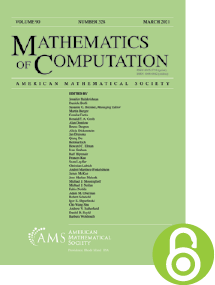Approximation by quadrilateral finite elements
HTML articles powered by AMS MathViewer
- by Douglas N. Arnold, Daniele Boffi and Richard S. Falk HTML | PDF
- Math. Comp. 71 (2002), 909-922 Request permission
Abstract:
We consider the approximation properties of finite element spaces on quadrilateral meshes. The finite element spaces are constructed starting with a given finite dimensional space of functions on a square reference element, which is then transformed to a space of functions on each convex quadrilateral element via a bilinear isomorphism of the square onto the element. It is known that for affine isomorphisms, a necessary and sufficient condition for approximation of order $r+1$ in $L^p$ and order $r$ in $W^1_p$ is that the given space of functions on the reference element contain all polynomial functions of total degree at most $r$. In the case of bilinear isomorphisms, it is known that the same estimates hold if the function space contains all polynomial functions of separate degree $r$. We show, by means of a counterexample, that this latter condition is also necessary. As applications, we demonstrate degradation of the convergence order on quadrilateral meshes as compared to rectangular meshes for serendipity finite elements and for various mixed and nonconforming finite elements.References
- Philippe G. Ciarlet, The finite element method for elliptic problems, Studies in Mathematics and its Applications, Vol. 4, North-Holland Publishing Co., Amsterdam-New York-Oxford, 1978. MR 0520174
- B. Nagy, On cosine operator functions in Banach spaces, Acta Sci. Math. (Szeged) 36 (1974), 281–289. MR 374995
- Herbert Federer, Geometric measure theory, Die Grundlehren der mathematischen Wissenschaften, Band 153, Springer-Verlag New York, Inc., New York, 1969. MR 0257325
- Vivette Girault and Pierre-Arnaud Raviart, Finite element methods for Navier-Stokes equations, Springer Series in Computational Mathematics, vol. 5, Springer-Verlag, Berlin, 1986. Theory and algorithms. MR 851383, DOI 10.1007/978-3-642-61623-5
- F. Kikuchi, M. Okabe, and H. Fujio, Modification of the 8-node serendipity element, Comp. Methods Appl. Mech. Engrg. 179 (1999), 91–109.
- R. H. McNeal and R. L. Harder, Eight nodes or nine?, Int. J. Numer. Methods Engrg. 33 (1992), 1049–1058.
- R. Rannacher and S. Turek, Simple nonconforming quadrilateral Stokes element, Numer. Methods Partial Differential Equations 8 (1992), no. 2, 97–111. MR 1148797, DOI 10.1002/num.1690080202
- P. Sharpov and Y. Iordanov, Numerical solution of Stokes equations with pressure and filtration boundary conditions, J. Comp. Phys. 112 (1994), 12–23.
- G. Strang and G. Fix, A Fourier analysis of the finite element variational method, Constructive Aspects of Functional Analysis (G. Geymonat, ed.), C.I.M.E. II Ciclo, 1971, pp. 793–840.
- Jing Zhang and Fumio Kikuchi, Interpolation error estimates of a modified 8-node serendipity finite element, Numer. Math. 85 (2000), no. 3, 503–524. MR 1760933, DOI 10.1007/s002110000104
- O. C. Zienkiewicz and R. L. Taylor, The finite element method, fourth edition, volume 1: Basic formulation and linear problems, McGraw-Hill, London, 1989.
Additional Information
- Douglas N. Arnold
- Affiliation: Institute for Mathematics and its Applications, University of Minnesota, Minneapolis, Minnesota 55455
- MR Author ID: 27240
- Email: arnold@ima.umn.edu
- Daniele Boffi
- Affiliation: Dipartimento di Matematica, Università di Pavia, 27100 Pavia, Italy
- MR Author ID: 348743
- Email: boffi@dimat.unipv.it
- Richard S. Falk
- Affiliation: Department of Mathematics, Rutgers University, Piscataway, New Jersey 08854
- Email: falk@math.rutgers.edu
- Received by editor(s): March 10, 2000
- Published electronically: March 22, 2002
- © Copyright 2002 American Mathematical Society
- Journal: Math. Comp. 71 (2002), 909-922
- MSC (2000): Primary 65N30, 41A10, 41A25, 41A27, 41A63
- DOI: https://doi.org/10.1090/S0025-5718-02-01439-4
- MathSciNet review: 1898739


